St. Therese of Lisieux
The Little Flower

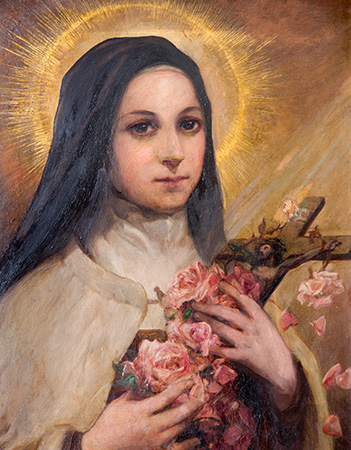
The Little Flower
Born: January 2, 1873 in Alencon, France
Died: September 30, 1897
Canonized: 1925 by Pope Pius XI
Feast Day: October 1
Patron Saint of: aviators, florists, missions, Russia
As a very young child, she told her father, who she was very close to, that she would be a saint. An older sister, Pauline, was the first to act on a call from God and entered the Carmelite Order; she was closely followed by another older sister, Marie. Here sisters’ consecration inspired Therese to follow in their footsteps. Because of her age, only nine, the local bishop discouraged Therese’s entering the Order. However, at the age of 14, Therese met Pope Leo XIII where she made a personal appeal to be allowed to become a Carmelite nun. Pope Leo XIII responded that that decision should be left to the bishop. When she was 15, that permission was finally given. After Therese’s father’s death, the last of the four sisters, Celine, also entered the convent.
As a Carmelite nun, she spent much of her time “alone with the Alone”, in prayer, meditation and penance. Leading this type of cloistered existence, no one, not even the other Carmelite nuns, knew that she had been on the receiving end of special favors and graces from God. During her lifetime, she was inspired to put to paper her life. She named her diary The History of a Soul. It was only after other Carmelite nuns had read her journal had they realized how special she was. Still today, The History of a Soul is widely recognized as one of the most beautiful works on spiritual life. Therese of Lisieux was later to be known as “Little Flower.”
“I will let fall from Heaven…a Shower of Roses” -St. Therese
Miraculous Invocation to St. Therese
O Glorious St. Thérèse, whom Almighty God has raised up to aid and inspire the human family, I implore your Miraculous Intercession. You are so powerful in obtaining every need of body and spirit from the Heart of God. Holy Mother Church proclaims you “Prodigy of Miracles… the Greatest Saint of Modern Times”. Now I fervently beseech you to answer my petition (mention here) and to carry out your promises of spending Heaven doing good upon earth… of letting fall from Heaven a Shower of Roses. Little Flower, give me you childlike faith, to see the Face of God in people and experiences of my life, and to love God with full confidence. St. Thérèse, my Carmelite Sister, I will fulfill your plea “to be made known everywhere” and I will continue to lead others to Jesus through you. Amen

The Little Flower
Born: January 2, 1873 in Alencon, France
Died: September 30, 1897
Canonized: 1925 by Pope Pius XI
Feast Day: October 1
Patron Saint of: aviators, florists, missions
This beautiful saint is the inspiration to this website and the Saint Thérèse of Lisieux (Born Marie-Françoise-Thérèse Martin, January 2, 1873 – September 30, 1897), or Saint Thérèse of the Child Jesus. Her Feast day is celebrated on the 1st of October. She is popularly known as “The Little Flower”.
Therese was born in France in 1873, the pampered daughter of a mother who had wanted to be a saint and a father who had wanted to be monk. The two had gotten married but determined they would be celibate until a priest had told them that was not how God wanted a marriage to work! They must have followed his advice very well because they had nine children. The five children who lived were all daughters who became Nuns.
Tragedy and loss came quickly to Therese when her mother died of breast cancer when she was four and a half years old. Her sixteen year old sister Pauline became her second mother — which made the second loss even worse when Pauline entered the Carmelite convent five years later. A few months later, Therese became so ill with a fever that people thought she was dying.
When Therese saw her sisters praying for intercession to a statue of Mary in her room, Therese also prayed. She saw Mary smile at her and suddenly she was cured.
Without realizing it, by the time she was eleven years old she had developed the habit of mental prayer. She would find a place between her bed and the wall and in that solitude think about God, life, eternity.
When her other sisters, Marie and Leonie, left to join the convent, Therese was left alone with her last sister Celine and her father. Therese tells us that she wanted to be good but that she had an odd way of going about it.
Every time Therese even imagined that someone was criticizing her or didn’t appreciate her, she burst into tears. Then she would cry because she had cried! Any inner wall she built to contain her wild emotions crumpled immediately before the tiniest comment.
Therese wanted to enter the convent to join her sisters Pauline and Marie but how could she convince others that she could handle the rigors of the convent life, if she couldn’t handle her own emotional outbursts? She had prayed that Jesus would help her but there was no sign of an answer.
On Christmas day in 1886, the fourteen-year-old hurried home from church. In France, young children left their shoes in front of the fireplace at Christmas, and then parents would fill them with gifts. By fourteen, most children outgrew this custom. But her sister Celine didn’t want Therese to grow up. So she continued to leave presents in “baby” Therese’s shoes.
As she and Celine climbed the stairs, their father’s voice rose up from the parlor below. Standing over the shoes, he sighed, “Thank goodness that’s the last time we shall have this kind of thing!”
Therese froze, and her sister looked at her helplessly. Celine knew that in a few minutes Therese would be in tears over what her father had said.
But the tantrum never came. Something incredible had happened to Therese. Jesus had come into her heart and done what she could not do herself. He had made her more sensitive to her father’s feelings than her own.
She swallowed her tears, walked slowly down the stairs, and exclaimed over the gifts in the shoes, as if she had never heard a word her father said. The following year at the young age of 15, she entered the convent after a pilgrimage to Rome to seek permission from the Pope. In her autobiography she referred to this Christmas as her “conversion.”
The world came to know Therese through her autobiography, “Story of a Soul”. She described her life as a “little way of spiritual childhood.” She lived each day with an unshakable confidence in God’s love. “What matters in life,” she wrote, “is not great deeds, but great love.” Therese lived and taught a spirituality of attending to everyone and everything well and with love. She believed that just as a child becomes enamored with what is before her, we should also have a childlike focus and totally attentive love. Therese’s spirituality is of doing the ordinary, with extraordinary love.
She loved flowers and saw herself as the “little flower of Jesus,” who gave glory to God by just being her beautiful little self among all the other flowers in God’s garden. Because of this beautiful analogy, the title “little flower” remained with St. Therese.
Her inspiration and powerful presence from heaven touched many people very quickly. She was canonized by Pope Pius XI on May 17, 1925. Had she lived, she would have been only 52 years old when she was declared a Saint.
“My mission – to make God loved – will begin after my death,” she said. “I will spend my heaven doing good on earth. I will let fall a shower of roses.” Roses have been described and experienced as Saint Therese’s signature. Countless millions have been touched by her intercession and imitate her “little way.” She has been acclaimed “the greatest saint of modern times.”
She is the patron saint of Missions, Aviators and Florists
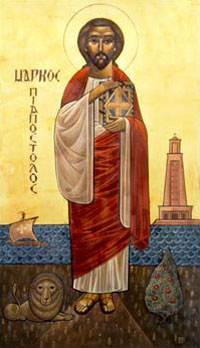
Born: 15 years after Jesus Christ birth
Died: c.74
Canonized:
Feast Day: April 25
Patron Saint of: lawyers, notaries, prisoners
Mark is symbolically portrayed as a lion because his Gospel begins with the history of John the Baptist, the voice crying from the wilderness, and he accents the miraculous powers of Jesus.
From the Synaxarium:
He was born in the Pentapolis or Qairawan (Now Tunisia or Libya according to other sources) approximately 15 years after our Lord was born.
He witnessed the preaching of our Lord in Palestine as well as his passion.
He is the author of the earliest Gospel to be written (it was written in Greek).
He was the founder of Christianity in Alexandria, Egypt. He came to Alexandria approximately 48 AD. Foot Note: According to some sources, St. Peter preached in Babylon about the same time St. Mark was in Alexandria, however he focused on the Jews of Babylon (A city near Memphis, Cairo now).
He was martyred in 68 AD when pagans of Serapis (the Serapion-Abbis Greek Egyptian God) tied him to a horse’s tail and dragged him through the streets of Alexandria’s district of Bokalia for two days until his body was torn to pieces.
The Church celebrates his martyrdom on the 8th of May each year.
His head is in a church named after him in Alexandria, and parts of his relics are in St. Mark’s Cairo’s Cathedral. The rest of his relics are in the San Marco Cathedral in Venice, Italy.
His titles are: The Evangelist, the Apostle, the Witness and the Martyr.
Mark the Evangelist (This link takes you to wikipedia.org that has comprehensive information on St.Mark)
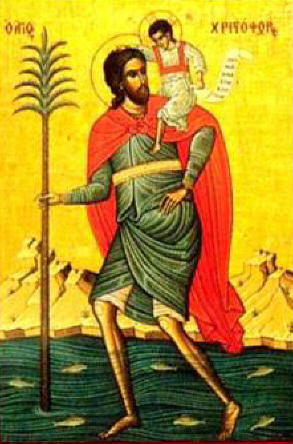
Born: unknown
Died: c.251
Canonized:
Feast Day: July 25
Patron Saint of: bookbinders, epilepsy, gardeners, mariners, pestilence, thunder-storms, travelers
A martyr, probably of the third century. Although St. Christopher is one of the most popular saints in the East and in the West, almost nothing certain is known about his life or death. A heathen king (in Canaan or Arabia), through the prayers of his wife to the Blessed Virgin, had a son, whom he called Offerus (Offro, Adokimus, or Reprebus) and dedicated to the gods Machmet and Apollo. Acquiring in time extraordinary size and strength, Offerus resolved to serve only the strongest and the bravest. He bound himself successively to a mighty king and to Satan, but he found both lacking in courage, the former dreading even the name of the devil, and the latter frightened by the sight of a cross at the roadside. For a time his search for a new master was in vain, but at last he found a hermit (Babylas?) who told him to offer his allegiance to Christ, instructed him in the Faith, and baptized him. Christopher, as he was now called, would not promise to do any fasting or praying, but willingly accepted the task of carrying people, for God’s sake, across a raging stream. One day he was carrying a child who continually grew heavier, so that it seemed to him as if he had the whole world on his shoulders. The child, on inquiry, made himself known as the Creator and Redeemer of the world. To prove his statement the child ordered Christopher to fix his staff in the ground. The next morning it had grown into a palm-tree bearing fruit. The miracle converted many. This excited the rage of the king (prefect) of that region (Dagnus of Samos in Lycia?). Christopher was put into prison and, after many cruel torments, beheaded.
The Greek legend may belong to the sixth century; about the middle of the ninth, we find it spread through France. Originally, St. Christopher was only a martyr, and as such is recorded in the old martyrologies. The simple form of the Greek and Latin passio soon gave way to more elaborate legends. We have the Latin edition in prose and verse of 983 by the subdeacon Walter of Speyer, “Thesaurus anecdotorum novissimus” (Augsburg, 1721-23), II, 27-142, and Harster, “Walter von Speyer” (1878). An edition of the eleventh century is found in the Acta SS., and another in the “Golden Legend” of Jacob de Voragine. The idea conveyed in the name, at first understood in the spiritual sense of bearing Christ in the heart, was in the twelfth or thirteenth century taken in the realistic meaning and became the characteristic of the saint. The fact that he was frequently called a great martyr may have given rise to the story of his enormous size. The stream and the weight of the child may have been intended to denote the trials and struggles of a soul taking upon itself the yoke of Christ in this world.
The existence of a martyr St. Christopher cannot be denied, as was sufficiently shown by the Jesuit Nicholas Serarius, in his treatise on litanies, “Litaneutici” (Cologne, 1609), and by Molanus in his history of sacred pictures, “De picturis et imaginibus sacris” (Louvain, 1570). In a small church dedicated to the martyr St. Christopher, the body of St. Remigius of Reims was buried, 532 (Acta SS., 1 Oct., 161). St. Gregory the Great (d. 604) speaks of a monastery of St. Christopher (Epp., x., 33). The Mozarabic Breviary and Missal, ascribed to St. Isidore of Seville (d. 636), contains a special office in his honour. In 1386 a brotherhood was founded under the patronage of St. Christopher in Tyrol and Vorarlberg, to guide travellers over the Arlberg. In 1517, a St. Christopher temperance society existed in Carinthia, Styria, in Saxony, and at Munich. Great veneration was shown to the saint in Venice, along the shores of the Danube, the Rhine, and other rivers where floods or ice-jams caused frequent damage. The oldest picture of the saint, in the monastery on the Mount Sinai dates from the time of Justinian (527-65). Coins with his image were cast at Würzburg, in Würtermberg, and in Bohemia. His statues were placed at the entrances of churches and dwellings, and frequently at bridges; these statues and his pictures often bore the inscription: “Whoever shall behold the image of St. Christopher shall not faint or fall on that day.” The saint, who is one of the fourteen holy helpers, has been chosen as patron by Baden, by Brunswick, and by Mecklenburg, and several other cities, as well as by bookbinders, gardeners, mariners, etc. He is invoked against lightning, storms, epilepsy, pestilence, etc. His feast is kept on 25 July; among the Greeks, on 9 March; and his emblems are the tree, the Christ Child, and a staff. St. Christopher’s Island (commonly called St. Kitts), lies 46 miles west of Antigua in the Lesser Antilles.
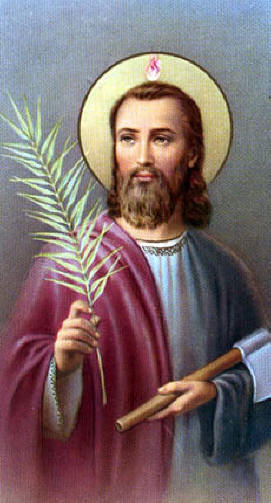
Born: Unknown
Died: beaten to death with a club, then beheaded post-mortem in 1st century Persia; relics at Saint Peter’s, Rome, at Rheims, and at Toulouse, France
Feast Day: October 28
Patron Saint of: desperate causes, desperate situations, lost causes
St, Jude was one of the Twelve Apostles of Jesus. He is generally identified with Thaddeus, and is also variously called Jude of James or Jude Thaddaeus. In the Roman Catholic Church, he is the patron saint of desperate cases and lost causes. Saint Jude’s attribute is a club/ axe. He is also often shown in icons with a flame around his head. This represents his presence at Pentecost, when he received the Holy Spirit with the other apostles. Another common attribute is Jude holding an image of Jesus Christ.
Saint Jude preached the Gospel in Judea, Samaria, Idumaea, Syria, Mesopotamia and Libya. Saint Jude suffered martyrdom about 65 AD in Beirut, in the Roman province of Syria. The axe that he is often shown holding in pictures symbolizes the way in which he was killed.
Feast day celebrated October 28th (Western Christianity); June 19th (Eastern Christianity)
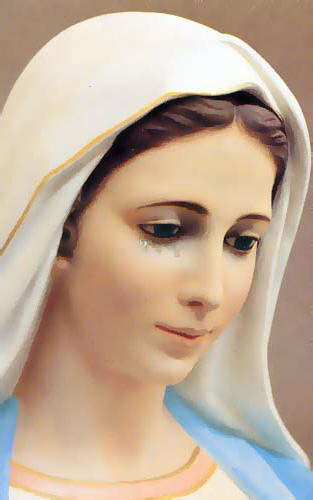
Born: unknown; celebrated September 8Died: assumed; celebrated August 15
Canonized: the day she was assumed
Feast Day: July 16
Mary, Mother of Jesus, who is venerated by the Roman Catholic Church(This link takes you to wikipedia.org that has comprehensive information on Mary)
Also known as: Adam’s Deliverance; Advocate of Eve; Advocate of Sinners; All Chaste; All Fair and Immaculate; All Good; Annunciation of the Blessed Virgin; Aqueduct of Grace; Archetype fo Purity and Innocence; Ark Gilded by the Holy Spirit; Ark of the Covenant Assumption of the Blessed Virgin; Basillica of Saint Mary Major; Blessed Among Women; Blessed Virgin Mary; Bridal Chamber of the Lord; Bride of Christ; Bride of Heaven; Bride of the Canticle; Bride of the Father; Bride Unbrided; Cause of Our Joy; Chosen Before the Ages; Comfort of Christians; Comforter of the Afflicted; Conceived Without Original Sin; Consoler of the Afflicated; Co-Redemptrix; Court of the Eternal King; Created Temple of the Creator; Crown of Virginity; Daughter of Men; David’s Daughter; Deliverer From All Wrath; Deliverer of Christian Nations; Destroyer of Heresies; Dispenser of Grace; Dwelling Place for God; Dwelling Place Meet for God; Dwelling Place of the Illimitable; Dwelling Place of the Spirit; Earth Unsown; Earth Untouched and Virginal; Eastern Gate; Ever Green and Fruitful; Ever Virgin; Eve’s Tears Redeeming; Exalted Above the Angels; Feast of the Immaculate Conception; Fleece of Heavenly Rain; Flower of Jesse’s Root; Formed Without Sin; Forthbringer of God; Forthbringer of the Ancient of Days; Forthbringer of the Tree of Life; Fountain of Living Water; Fountain Sealed; Free From Every Stain; Full of Grace; Garden Enclosed; Gate of Heaven; God’s Eden; God’s Olive Tree; God’s Vessel; Handmaid of the Lord; Healing Balm of Integrity; Health of the Sick; Helper of All in Danger; Holy in Soul and Body; Holy Mountain of Our Lady; Hope of Christians; House Built by Wisdom; House of Gold; Immaculate; Immaculate Conception; Immaculate Heart; Immaculate Heart of Mary; Immaculate Mary; Immaculate Mother; Immaculate Virgin; Incorruptible Wood of the Ark; Inventrix of Grace; Inviolate; Joseph’s Spouse; Kingly Throne; King’s Mother; Lady Most Chaste; Lady Most Venerable; Lady of Good Help; Lady of Grace; Lady of Mercy; Lady of Peace; Lady of Perpetual Help; Lady of the Rosary; Lady of Sorrows; Lady of Victory; Lamp Unquenchable; Life-Giver to Posterity; Light Cloud of Heavenly Rain; Lily Among Thorns; Living Temple of the Diety; Loom of the Incarnation; Madonna; Madonna of Saint Luke; Marketplace for Salutary Exchange; Mary of the Hurons; Mary the Blessed Virgin; Mary; Blessed Virgin; Mary; Help of Christians; Mary; Mother of God; Mary; Queen of Africa; Mary; Queen of Angels; Mary; Queen of Peace; Mary; Star of the Sea; Mediatrix; Mediatrix and Conciliatrix; Mediatrix of All Graces; Mediatrix of Salvation; Mediatrix of the Mediator; Minister of Life; Mirror of Justice; More Beautiful Than Beauty; More Glorious Than Paradise More Gracious Than Grace; More Holy Than the Cherubim, the Seraphim and the Entire Angelic Hosts; Morning Star; Most Venerable; Mother and Virgin; Mother Most Admirable; Mother Most Amiable; Mother Most Chaste; Mother Most Pure; Mother Inviolate; Mother of Christians; Mother of Christ’s Members; Mother of Divine Grace; Mother of God; Mother of Good Counsel; Mother of Jesus Christ; Mother of Men; Mother of Our Creator; Mother of Our Head; Mother of Our Savior; Mother of the Church; Mother of the Mystical Body; Mother of Wisdom; Mother Undefiled; My Body’s Healing; My Soul’s Saving; Mystical Rose; Nativity of the Blessed Virgin; Nature’s Re-Creation; Nature’s Restoration; Neck of the Mystical Body; Never Fading Wood; New Eve; Notre Dame Cathedral of Paris; Notre Dame of Chartres; Notre Dame of Easton; Nourisher of God and Man; Olive Tree of the Father’s Compassion; Only Bridge of God to Men; Our Immaculate Queen; Our Lady; Gate of Heaven; Our Lady; Help of Christians; Our Lady; Mother of the Church; Our Lady; Queen of All Saints; Our Lady; Queen of the Apostles; Our Lady in America; Our Lady Mediatrix of All Grace; Our Lady of Africa; Our Lady of Altotting; Our Lady of Bandel; Our Lady of Bandra; Our Lady of Banneux; Our Lady of Baeuraing; Our Lady of Calvary; Our Lady of Charity; Our Lady of Consolation; Our Lady of Copacabana; Our Lady of Czestochowa; Our Lady of Europe; Our Lady of Fatima; Our Lady of Good Council; Our Lady of Good Help; Our Lady of Good Remedy; Our Lady of Grace; Our Lady of Guadalupe; Our Lady of Guadalupe of Estramadura; Our Lady of High Grace; Our Lady of Hungary; Our Lady of Japan; Our Lady of Kevelaer; Our Lady of Knock; Our Lady of La Leche; Our Lady of La Vang; Our Lady of Las Vegas; Our Lady of LaSallette; Our Lady of Limerick; Our Lady of Loreto; Our Lady of Lourdes; Our Lady of Lujan; Our Lady of Madhu; Our Lady of Mariazell; Our Lady of Medjugore; Our Lady of Mercy; Our Lady of Montserrat; Our Lady of Mount Carmel; Our Lady of Mount Carmel at Aylesford; Our Lady of Nazareth; Our Lady of Peace; Our Lady of Perpetual Help; Our Lady of Pompeii Our Lady of Pontmain; Our Lady of Prompt Succor; Our Lady of Providence; Our Lady of Ransom; Our Lady of Safe Travel; Our Lady of Salambao; Our Lady of Shongweni; Our Lady of Sorrows; Our Lady of Tears; Our Lady of Victory; Our Lady of Walsingham; Our Lady of the Americas; Our Lady of the Assumption; Our Lady of the Cape; Our Lady of the Gulf; Our Lady of the Hermits; Our Lady of the Highways; Our Lady of the Holy Rosary; Our Lady of the Holy Souls; Our Lady of the Immaculate Conception; Our Lady of the Incarnation; Our Lady of the Kodiak and the Islands; Our Lady of the Milk and Happy Delivery; Our Lady of the Miraculous Medal; Our Lady of the Pillar of Saragossa; Our Lady of the Pines; Our Lady of the Prairie; Our Lady of the Presentation; Our Lady of the Rosary; Our Lady of the Scapular; Our Lady of the Snows; Our Lady of the Turumba; Our Lady of the Valley; Our Lady of the Wayside; Our Lady of the Woods; Our Lady Who Appeared; Our Own Sweet Mother; Paradise Fenced Against the Serpent; Paradise of Innocence and Immortality; Paradise of the Second Adam; Paradise Planted by God; Patroness and Protectoress; Perfume of Faith; Preserved From All Sin; Protectress From All Hurt; Queen of All Saints; Queen of Angels; Queen of Creation; Queen of Heaven; Queen of Heaven and Earth; Queen of Martyrs; Queen of Peace; Queen Unconquered; Refuge in Time of Danger; Refuge of Sinners; Reparatrix; Reparatrix of Her Parents; Reparatrix of the Lord World; Rich in Mercy Rose Ever Blooming; Sacred Heart of Mary; Sanctuary of the Holy Spirit; Scepter of Orthodoxy; Seat of Wisdom; Second Eve; Singular Vessel of Devotion; Sister and Mother; Source of Virginity; Spiritual Vessel; Spotless Dove of Beauty; Star of the Sea; Star That Bore the Sea; Suppliant for Sinners; Surpassing Eden’s Gardens; Surpassing the Heavens; Surpassing the Seraphim; Sweet Flowering and Gracious Mercy; Tabernacle of God; Tabernacle of the Word; Temple Divine; Temple Indestructible; Temple of the Lord’s Body; Theotokos; Throne of the King; Tower of David; Tower of Ivory; Tower Unassailable; Treasure House of Life Treasure of Immortality; Treasure of the World Undefiled; Undefiled Treasure of Virginity; Undug Well of Remission’s Waters; Unlearned in the Ways of Eve; Unplowed Field of Heaven’s Bread; Unwatered Vineyard of Immortality’s Wine; Vessel of Honor; Victor Over the Serpent; Virgin Inviolate; Virgin Most Faithful; Virgin Most Merciful; Virgin Most Powerful; Virgin Most Prudent; Virgin Most Pure; Virgin Mother; Virgin of Charity; Virgin of Copacabana; Virgin of Virgins; Wedded to God; Woman Clothed With the Sun; and Workshop of the Incarnation.
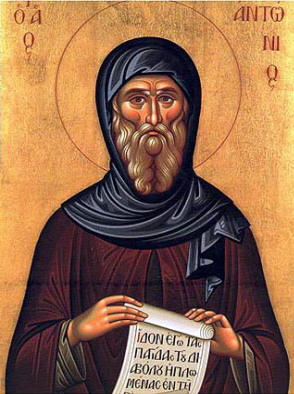
Also known as Anthony of Egypt; Anthony the Abbot; Father of Cenobites; Father of Monasticism
Born: 251, Heracleus, Egypt
Died: 356, Mount Colzim
Coptic Feast Day: January 30th
Patron Saint of: amputees; animals; basket makers; brushmakers; Burgio, Sicily; butchers; domestic animals; eczema; epilepsy, ergotism; erysipelas; graveyards; hermits; Hospitallers; monks; pigs; relief from pestilence; Saint Anthony’s fire; skin diseases; skin rashes; swineherds
Following the death of his parents when he was about 20, he insured that his sister completed her education, then sold his house, furniture, and the land he owned, gave the proceeds to the poor, joined the anchorites who lived nearby, and moved into an empty sepulchre. At age 35 he moved alone to the desert, living 20 years in an abandoned fort.
Anthony barricaded the place for solitude, but admirers broke in. He miraculously healed people, and agreed to be the spiritual counselor of others. His recommendation was to base life on the Gospel. Word spread, and so many disciples arrived that Anthony founded two monasteries on the Nile, one at Pispir, one at Arsinoe. Many of those who lived near him supported themselves by making baskets and brushes, and from that came his patronage of those trades.
Anthony briefly left his seclusion in 311, going to Alexandria to fight Arianism, and to comfort the victims of Maximinus’ persecution. At some point in his life, he met with his sister again. She, too, had withdrawn from the world, and directed a community of nuns. Anthony retired to the desert, living in a cave on Mount Colzim.
Descriptions paint him as uniformly modest and courteous. His example led many to take up the monastic life, and to follow his way. Friend late in life, Saint Paul the Hermit buried the aged anchorite, leading to his patronage of gravediggers. His biography was written by his friend Saint Athanasius.
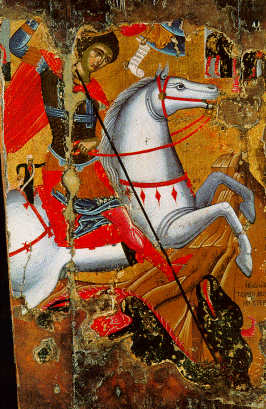
Born: unknown
Died: c.304
Canonized:
Feast Day: April 23
Patron Saint of: Boy Scouts, England, soldiers
Saint George, the Great Martyr, was born in Cappodocia and raised a Christian. After his father’s death, St. George’s mother took him to Palestine where she had some farm land. At a young age, he served in the Roman army under the Emperor Diocletian and was commended many times for his excellent service to the Empire. From the rule of the Emperor Decian, until 284 A.D., when Diocletian became Emperor, the Christian Church went through a period of peace and prosperity. During that time, the Christians obtained important positions in the government, built many churches and schools, and organized the authoritative structure of the Church. Diocletian gave many of his loyal officers political positions so that he could have the military strength of his Empire on his side.
After Diocletian had suppressed the barbarian tribes which were attacking the Empire and secured its borders, he began to concentrate on the Empire’s internal affairs. Diocletian believed that a state religion could keep an Empire united. Since paganism was the state religion, Diocletian focused his efforts toward the suppression of Christianity.
During the year 303 A.D., Diocletian summoned his aides to meet in Caesarea, a city of the Eastern Roman Empire. He held three general meetings with his aides, instructing them to persecute the Christians. Since St. George had shown his excellence while serving in the army, he was among these aides. Diocletian asked them to pledge their allegiance to this cause by making pagan sacrifices as proof of their loyalty. All of the aides pledged their loyalty, except for the Saint. He stood in front of Diocletian and admitted to being a Christian. The Emperor ordered him to be taken to prison and that a boulder be placed on his chest as a form of torture. The next morning Diocletian ordered that the prisoner be brought before him for questioning. George stood steadfast and told Diocletian of his belief in the riches of the Kingdom of Heaven.
The Emperor then summoned the executioners to take the Saint and have him bound to the rim of a wheel set with sharp spikes. Diocletian admired the courage of the Saint and asked him to sacrifice to the gods to save himself. He refused Diocletion’s request. After praying to God, he heard a voice from heaven saying, “Do not fear, George, I am with you.” With Christs help, the spiked wheel had no effect upon Saint George. When the Saint appeared before Diocletian not only was he unharmed, but an angelic aura had settled about him. Suddenly, two officers of the Roman army, Anatolios and Protoleon, appeared before Diocletian with two thousand soldiers. They confessed their belief in Christ and Diocletian had them all executed.
The Emperor then ordered that iron sandals be tied to the feet of the Saint and that he be made to run. As he ran, he was beaten. One of Diocletian’s advisors, Magnentios, ordered St. George to perform a miracle. They happened to pass by a tomb of a man who had been dead for many years. Magnentios ordered St. George to resurrect this man to show the power of his God. After praying for a long time, he rolled the rock away from the tomb and resurrected the dead man. The by-standers praised the strength of Christ. Many were converted to Christianity because of this great miracle.
The Emperor continued to torture St. George but to no avail. Diocletian was convinced that all of St.George’s miracles were done by magic. He therefore, called upon Athanasius the Magician to break this magic. He gave the Saint a cup full of poison to drink. St. George made the sign of the cross over the cup then drank it. When no harm came upon him, the magician believed in the Lord Christ, and received the crown of martyrdom. The Emperor became raged and ordered to squeeze him until he delivered up his soul, and they cast his body outside the city.
The Lord Christ raised him up, and the Saint returned to the city. When the people saw him, three thousand and seven hundred souls believed. The Emperor ordered to cut off their heads and they received the crown of martyrdom. After seeing the miracles of Saint George, Diocletian’s wife, the Empress Alexandra, also confessed her belief in Christ. Diocletian imprisoned her and had her killed and she received the crown of martyrdom. Finally, Diocletian decided to put an end to the humiliation that befell him, so he ordered to cut off the head of St. George, and he received the crown of martyrdom. A Christian took the body, wrapped it in expensive shrouds, and took it to the city of Lydda, his home town, and they built a great church on his name there.
From the history of the church, the story is told of the dragon and St. George. This dragon threatened the idolaters in the area of Atalia. The dragon or crocodile makes its nest at the spring that provides water for the city. Consequently, the citizens have to dislodge the dragon from its nest for a time, to collect water. To do so, each day they offer the dragon at first a sheep, and if no sheep can be found, then a maiden is the best substitute for one. The victim is chosen by drawing lots. One day, this happens to be the princess. The monarch begs for her life to be spared, but the people refuse. She is offered to the dragon, but then St George appears on his travels. He faces the dragon, protects himself with the sign of the Cross, slays the dragon, and rescues the princess. The citizens abandon their paganism and convert to Christianity.
St. George is also celebrated on April 23rd and is the patron saint of England, Portugal, Georgia, Syria, Lebanon and Malta. St, George is connected with a large number of patronages throughout the world and his iconography can be found on the flags and coats of arms of a number of cities and countries.